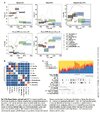Three major genetic studies exploring the migration ancestry of the southern arc countries (Western Asia and Southern Europe) have been simultaneously published in journal Science. Covering the period from the PPN to Medieval Europe, all three reveal results laden with implication but in particular for those studying the imperial history of Rome, are the results of paper 3 which also covers The Bronze Age Aegean world, The era of Greek colonization, The Urartian Kingdom and its neighbors in Iran and Mesopotamia, and Medieval migrations into Anatolia and the Balkans.
First, some study context:
The Southern Arc and its lively genetic History
So on to an overview of chronologically paper 3:
The full paper 3 is attached below in PDF form.
First, some study context:
The Southern Arc and its lively genetic History
25.08.2022
A large-scale paleogenetic study of ancient populations from cultures and civilizations from western Asia and Southern Europe from the early Copper Age until the late middle ages reveals insights on migration patterns, genetics and interactions between the earliest farmer groups, and the origins and spread of Indo-European languages.
The Southern Arc – a bridge between Europe and Asia
Some of the earliest civilizations emerged and flourished in the ‘Southern Arc,’ a geographic region that stretches from the Caucasus and the Levant, across Anatolia and the Aegean into the Balkans; forming a bridge between Europe and Asia.
Across this arc various ancient human cultures formed, and spread. These cultures, whether lost to history or surviving down to the present day, are not only the heritage of the people of the region, but made a profound impact on human civilization as a whole.
At present, our knowledge about the people of many of these cultures, their movements, mating patterns and languages, is patchy. Paleogenetic research can cast new light on the lifeways of the people of past societies and the spread and diversification of their languages. However, addressing big questions about the past with paleogenetics requires large-scale systematic research which fills many of the current geographic and temporal gaps with which we can piece the puzzle.
In a trio of papers published simultaneously in the journal Science which report genome-wide data from 727 distinct ancient individuals—more than doubling the amount of ancient DNA data from this region and filling in major gaps in the paleogenetic record—a team of researchers led by Ron Pinhasi at the Department of Evolutionary Anthropology and Human Evolution and Archaeological Sciences (HEAS) at the University of Vienna, Songül Alpaslan-Roodenberg at the University of Vienna and Harvard University, and Iosif Lazaridis and David Reich at Harvard University—together with 202 co-authors—leverage their data to test longstanding archaeological, genetic and linguistic hypotheses. They present a systematic picture of the interlinked histories of peoples across this region from the origins of agriculture, to late medieval times.
So on to an overview of chronologically paper 3:
The Historic Period
This paper - “A genetic probe into the ancient and medieval history of Southern Europe and West Asia”- reveals how polities of the ancient Mediterranean world preserved contrasts of ancestry since the Bronze Age but were linked by migration.
The analyses support the theory that the ancient “Mycenaeans” of Greece can be modelled as a mixture in an approximately 1:10 ratio of a Yamnaya-like steppe-derived population and a “Minoan”/Early Bronze Age-like Aegean population, on average, but with previously unknown variation clarifying social aspects of the blending process:
“The Mycenaean gene pool was not monolithic,” says Iosif Lazaridis. Steppe ancestry was common, at low levels, in both elite and non-elite individuals. Some elite men traced their paternal descent to steppe populations, but others, like the Griffin Warrior near ancient Pylos from whom we recovered DNA, did not have any steppe ancestry at all. “We have to imagine steppe migrants as a population element that became integrated, both socially and genetically, into Aegean societies, and not as a people apart that dominated them.”
The results also show that the ancestry of people who lived around Rome in the Imperial period was almost identical to that of Roman/Byzantine individuals from Anatolia in both their mean and pattern of variation, while Italians prior to the Imperial period had a very different distribution. This suggests that the Roman Empire in both its shorter-lived western part and the longer-lasting eastern part centered on Anatolia had a diverse but similar population plausibly drawn to a substantial extent from Anatolian pre-Imperial sources.
“We knew from our previous research that people who lived around Rome in the Imperial period were from various regions and that many originated from the Near East,” says Ron Pinhasi who co-led a 2019 Science study that studied ancient DNA data from Rome. “But it was a complete surprise to find such a specific and clear link to Anatolia itself, and not to other eastern parts of the Roman Empire such as the Levant.”
The full paper 3 is attached below in PDF form.

